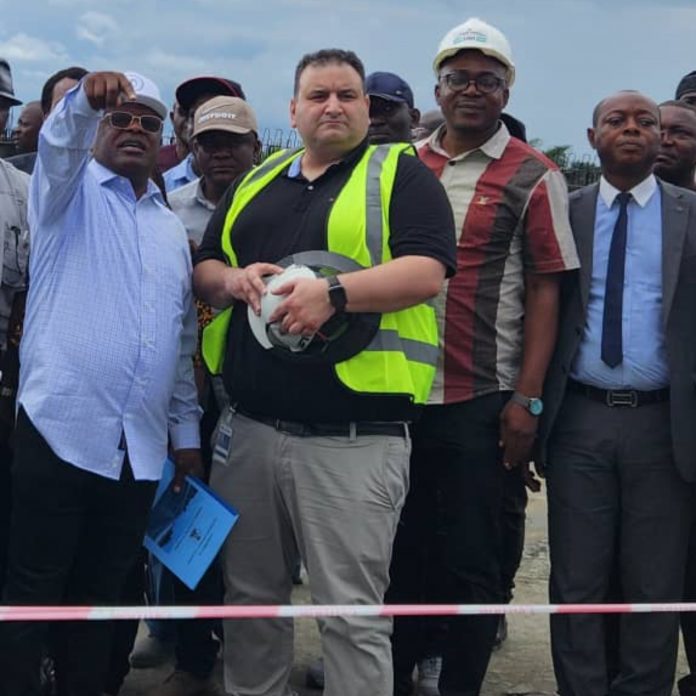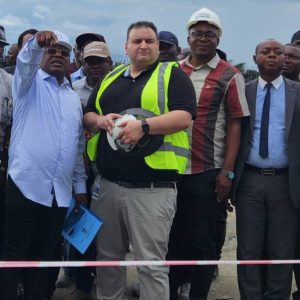Umahi, left, and Julius Berger’s Team Lead during the minister’s working visit to the Bodo-Bonny road project site in Rivers State recently
By Our Reporter
The contractors handling the strategic Bodo-Bonny Road (BBR) project, Julius Berger Nigeria Plc, has once more been commended for the good quality of engineering construction work they are doing across the country.
The commendation for the company’s qualitative works came again from the Honourable Minister of Works, Engr. Dave Umahi during his inspection visit to the on-going and fast moving Bodo-Bonny Road project linking the Rivers state mainland to Bonny Island widely known for its abundant oil and gas resources as well as for its rich socio-cultural history. Minister Umahi who also factually acknowledged Julius Berger’s strong commitment to good engineering construction quality during his inspection visit to the Abuja-Kano Road project a few weeks ago, said, “… “Once again I can tell you, Julius Berger remains consistent in delivering topnotch quality, and is doing a great work here in the Bodo-Bonny Road project.“
The visibly professionally passionate Engr. David Umahi and the Julius Berger project management experts, however, mutually analysed and some technical ideas on the project‘s ‘design ideology‘ for greater sustainability of the project to the admiration of the appreciative audience. Significantly, the Minister also noted that “If you pay them (Julius Berger), they will be fast with the job as you can see that they have done in the Bodo-Bonny Road project”. Engr. Thomas Balzuweit, the Julius Berger Team Lead thanked the Honourable Minister for his kind and gracious words to the company.
The visit started with the minister addressing the project consultants where he emphasised the government’s desire for new roads to exchanged be constructed in concrete. The leader of the Julius Berger delegation that received the Minister, Engr. Thomas Balzuweit explained that currently the Bodo-Bonny road is planned as an asphalt road, except the last 6 Km on Bonny Island due to extremely challenging soil conditions and expected long-term settlements of up to 30cm over a period of 30 years.
During a stop at Km 7, the Julius Berger Team Lead, Engr. Thomas Balzuweit explained the design philosophy and construction process to the Honourable Minister. He expressed the company’s technical confidence that the dam will be durable once constructed. Minister Dave Umahi requested a confirmation of the design life of the road and shared his design ideas.
While the Honourable Minister said he would be back to visit the fast-moving project again soon, he also requested a further joint analysis of the design between his team and the contractors.
The Bodo-Bonny Road project has a total length of 38 km road, with about 14 Km located through low-lying marshy and swampy terrain; and about 13 Km lying through a soft soil terrain. The project also consists of three main bridges which include the 501.5 m Afa Bridge, the 713.5 m Opobo Bridge; and the 448.5 m Nanabie Bridge. The Bodo-Bonny Road project also consists of 9 nos. mini bridges with different
2 / 5
length, 1 pipeline crossing bridge and many culverts as well as a 6 km concrete Bonny Town road with 13 nos. pipeline crossings.
Enquiries reveal that, due to extremely challenging soil conditions, multiple geological investigations were carried out by the government in order to implement the most feasible option for the implementation of the strategic project.
Based on the design approved by the Government and opinion of experts, the most feasible and officially accepted works implementation option consisted of nearly 10 million meters of vertical drains (PVD), more than 500,000 m² of geotex reinforcement, replacement of culverts with mini-bridges as well as the execution of approach bridges. These were all rooted in efficient considerations of cost, time and technical effectiveness and long-term durability.


